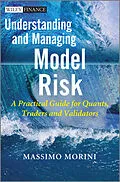A guide to the validation and risk management of quantitative
models used for pricing and hedging
Whereas the majority of quantitative finance books focus on
mathematics and risk management books focus on regulatory aspects,
this book addresses the elements missed by this literature--the
risks of the models themselves. This book starts from regulatory
issues, but translates them into practical suggestions to reduce
the likelihood of model losses, basing model risk and validation on
market experience and on a wide range of real-world examples, with
a high level of detail and precise operative indications.
Autorentext
Massimo Morini is Head of Credit Models and Coordinator of Model Research at IMI Bank of Intesa San Paolo. He has spent the last ten years inventing new models, implementing them, and helping practitioners in using them for buying, selling, and hedging derivatives. This has exposed him to the most practical side of model risk, and has led him to investigate model uncertainty, model robustness, and the management of the risk of model losses.
Massimo is also Professor of Fixed Income at Bocconi University and was a Research Fellow at Cass Business School, City University London. He regularly delivers advanced training in London New York and worldwide on model risk management, credit modelling, interest rate models and correlation modelling, where he teaches cutting edge innovations in quantitative finance and discusses their implications with practitioners from the major institutions. He has led workshops on financial modelling and the financial crisis at major international conferences, including Global Derivatives, the Quant Congress, and the Fixed Income Conference. He has published papers in journals including Risk Magazine, Mathematical Finance, and the Journal of Derivatives.
Massimo holds a PhD in Mathematics and an MSc in Economics.
Klappentext
The proliferation of increasingly complex pricing models has vastly expanded the operational capabilities of financial institutions within financial markets. However, it has also increased the industry's reliance on quantitative instruments, and created massive model risk. Consequently, model validation and model risk management are crucial tools for success in the market. Understanding and Managing Model Risk: A Practical Guide for
- Examines the risks arising from the use of models in calibration, pricing, hedging, correlation modelling, extrapolation and statistical arbitrage. Tackles modern day modelling issues including funding and market liquidity, CSA discounting, basis risk, counterparty risk, approximation errors, regulatory uncertainties and stress-testing. Investigates consensus models and how consensus can suddenly break down. Explores in detail examples from interest rate, credit and hybrid markets, covering also equity and cross-currency risks. Analyzes and compares a range of models including stochastic and local volatility, jumps, Libor and SABR models, copulas, structural and reduced-form models.
Zusammenfassung
A guide to the validation and risk management of quantitative models used for pricing and hedging
Whereas the majority of quantitative finance books focus on mathematics and risk management books focus on regulatory aspects, this book addresses the elements missed by this literature--the risks of the models themselves. This book starts from regulatory issues, but translates them into practical suggestions to reduce the likelihood of model losses, basing model risk and validation on market experience and on a wide range of real-world examples, with a high level of detail and precise operative indications.
Inhalt
Preface xi
Acknowledgements xix
Part I Theory and Practice of Model Risk Management
1 Understanding Model Risk 3
1.1 What Is Model Risk? 3
1.1.1 The Value Approach 4
1.1.2 The Price Approach 6
1.1.3 A Quant Story of the Crisis 9
1.1.4 A Synthetic View on Model Risk 17
1.2 Foundations of Modelling and the Reality of Markets 22
1.2.1 The Classic Framework 22
1.2.2 Uncertainty and Illiquidity 30
1.3 Accounting for Modellers 38
1.3.1 Fair Value 38
1.3.2 The Liquidity Bubble and the Accountancy Boards 40
1.3.3 Level 1, 2, 3 .go? 41
1.3.4 The Hidden Model Assumptions in 'vanilla' Derivatives 42
1.4 What Regulators Said After the Crisis 48
1.4.1 Basel New Principles: The Management Process 49
1.4.2 Basel New Principles: The Model, The Market and The Product 51
1.4.3 Basel New Principles: Operative Recommendations 52
1.5 Model Validation and Risk Management: Practical Steps 53
1.5.1 A Scheme for Model Validation 54
1.5.2 Special Points in Model Risk Management 59
1.5.3 The Importance of Understanding Models 60
2 Model Validation and Model Comparison: Case Studies 63
2.1 The Practical Steps of Model Comparison 63
2.2 First Example: The Models 65
2.2.1 The Credit Default Swap 66
2.2.2 Structural First-Passage Models 67
2.2.3 Reduced-Form Intensity Models 69
2.2.4 Structural vs Intensity: Information 72
2.3 First Example: The Payoff. Gap Risk in a Leveraged Note 74
2.4 The Initial Assessment 77
2.4.1 First Test: Calibration to Liquid Relevant Products 77
2.4.2 Second Test: a Minimum Level of Realism 78
2.5 The Core Risk in the Product 81
2.5.1 Structural Models: Negligible Gap Risk 82
2.5.2 Reduced-Form Models: Maximum Gap Risk 82
2.6 A Deeper Analysis: Market Consensus and Historical Evidence 85
2.6.1 What to Add to the Calibration Set 85
2.6.2 Performing Market Intelligence 86
2.6.3 The Lion and the Turtle. Incompleteness in Practice 86
2.6.4 Reality Check: Historical Evidence and Lack of it 87
2.7 Building a Parametric Family of Models 88
2.7.1 Understanding Model Implications 93
2.8 Managing Model Uncertainty: Reserves, Limits, Revisions 95
2.9 Model Comparison: Examples from Equity and Rates 99
2.9.1 Comparing Local and Stochastic Volatility Models in Pricing Equity Compound and Barrier Options 99
2.9.2 Comparing Short Rate and Market Models in Pricing Interest Rate Bermudan Options 105
3 Stress Testing and the Mistakes of the Crisis 111
3.1 Learning Stress Test from the Crisis 111
3.1.1 The Meaning of Stress Testing 112
3.1.2 Portfolio Stress Testing 113
3.1.3 Model Stress Testing 116
3.2 The Credit Market and the 'Formula that Killed Wall Street' 118
3.2.1 The CDO Payoff 118
3.2.2 The Copula 119
3.2.3 Applying the Copula to CDOs 122
3.2.4 The Market Quotation Standard 124
3.3 Portfolio Stress Testing and the Correlation Mistake 125
3.3.1 From Flat Correlation Towards a Realistic Approach 126
